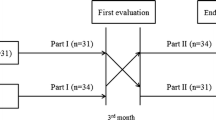Abstract
To evaluate the Mean Platelet Volume (MPV) levels in children diagnosed with familial Mediterranean fever (FMF), during attack and attack-free periods. The records of a total of 117 children with FMF, diagnosed using the Tel-Hashomer criteria, have been scanned. The study consisted of 53 patients during an attack (group 1), 64 patients in attack-free period (group 2), and 57 healthy controls (group 3). Erythrocyte sedimentation rate, C-reactive protein, white blood cell count, platelet count, and MPV levels were retrospectively recorded. The MPV and platelet values in FMF patients during attack (group 1) and FMF patients during attack-free periods (group 2) have been found to be significantly higher than those of the health control group (group 3). Positive correlation has been found between the MPV and platelet values in Group 1 and the disease’s severity score (r = 0.224, and r = 0.268, respectively). Positive correlation (r = 0.528, and r = 0.485, respectively) has been also identified between MPV and blood platelet count in patients in Group 1 and 2. No correlation was found between the Colchicine treatment period and MPV (r = −0.005). The MPV values in the complete group of FMF diagnosed children have been found to be much higher compared to those in healthy children. As a consequence, we consider the MPV value as a useful marker that demonstrates the risk of early stage atherosclerosis in children with FMF.
Similar content being viewed by others
References
El-Shanti H, Majeed HA, El-Khateeb M (2006) Familial mediterranean fever in Arabs. Lancet 367(9515):1016–1024
Cassidy JT, Petty RE (2005) Periodic fever syndromes in children. In: Cassidy JT, Petty RE (eds) Textbook of pediatric rheumatology, 5th edn. Elsevier, Philadelphia, pp 657–690
Gershoni-Baruch R, Shinawi M, Leah K, Badarnah K, Brik R (2001) Familial mediterranean fever: prevalence, penetrance and genetic drift. Eur J Hum Genet 9:3–7
Kone-Paut I, Dubuc M, Sportouch J et al (2000) Phenotype-genotype correlation in 91 patients with familial mediterranean fever reveals a high frequency of cutaneomucous features. Rheumatol 39:1275–1279
Daniels M, Shohat T, Brenner-Ullman A, Shohat VI (1995) Familial mediterranean fever: high gene frequency among the non-Ashkenazic and Ashkenazic Jewish populations in Israel. Am J Med Genet 55:311–314
Bagci S, Toy B, Tuzun A et al (2004) Continuity of cytokine activation in patients with familial mediterranean fever. Clin Rheumatol 23:333–337
Zemer D, Pras M, Sohar E et al (1974) Colchicine in the prevention and treatment of the amyloidosis of familial mediterranean fever. New Eng J Med 314:1001–1005
Caliskan M, Gullu H, Yilmaz S et al (2007) Impaired coronary microvascular function in familial mediterranean fever. Atherosclerosis 195:161–167
Akdoğan M, Calguneri M, Yavuz B et al (2006) Are familial mediterranean fever (FMF) patients at risk for atherosclerosis? Impaired endothelial function and increased intima media thickness. J Am Coll Cardiol 48:2351–2353
Peru H, Altun B, Doğan M et al (2008) The evaluation of carotid intima-media thickness in children with familial mediterranean fever. Clin Rheumatol 27:689–694
Bilginer Y, Ozaltin F, Basaran C et al (2008) Evaluation of intima media thickness of the common and internal carotid arteries with inflammatory markers in familial mediterranean fever as possible predictors for atherosclerosis. Rheumatol Int 28:1211–1216
Ross R (1986) The pathogenesis of atherosclerosis—an update. New Eng J Med 314:488–500
Sarı I, Karaoglu O, Can G et al (2007) Early ultrasonographic markers of atherosclerosis in patients with familial mediterranean fever. Clin Rheumatol 26:1467–1473
Martin JF, Trowbridge EA, Salmon G et al (1983) The biological significance of platelet volume: its relationship to bleeding time, thromboxane B2 production and megakaryocyte nuclear DNA concentration. Thromb Res 32:443–460
Turkish FMF Study Group (2005) Familial mediterranean fever in Turkey; results of a nationwide multicenter study. Medicine 84:1–11
Coban E, Adanir H (2008) Platelet activation in patients with familial mediterranean fever. Platelets 19:405–408
Makay B, Turkyilmaz Z, Unsal E (2009) Mean platelet volume in children with familial mediterranean fever. Clin Rheumatol 28:975–978
Thompson CB, Eaton KA, Princiotta SM et al (1982) Size dependent platelet subpopulations: relationship of platelet volume to ultrastructure, enzymatic activity, and function. Br J Haematol 50:509–519
Kilciler G, Genc H, Tapan S et al (2010) Mean platelet volume and its relationship with carotid atherosclerosis in subjects with non-alcoholic fatty liver disease. Upsala J Med Sci 115:253–259
Seyahi E, Ugurlu S, Cumali R, et al (2005) Subclinical atherosclerosis in familial mediterranean fever. In: Proceedings of the 4th international congress on systemic auto-inflammatory diseases. FMF and Beyond, NIAMS, Bethesda, pp 6–10
Clarke D, Johnson PW, Banks RE et al (1996) Effects of interleukin 6 administration on platelets and haemopoietic progenitor cells in peripheral blood. Cytokine 8:717–723
Baykal Y, Saglam K, Yilmaz MI et al (2003) Serum sIL-2r, IL-6, IL-10 and TNF-alpha level in familial mediterranean fever patients. Clin Rheumatol 22:99–101
Kaser A, Brandacher G, Steurer W et al (2001) Interleukin-6 stimulates thrombopoiesis through thrombopoietin: role in inflammatory thrombocytosis. Blood 98:2720–2725
Van Gameren MM, Willemse PH, Mulder NH et al (1994) Effects of recombinant human interleukin-6 in cancer patients: a phase I–II study. Blood 84:1434–1441
Author information
Authors and Affiliations
Corresponding author
Rights and permissions
About this article
Cite this article
Arıca, S., Özer, C., Arıca, V. et al. Evaluation of the mean platelet volume in children with familial Mediterranean fever. Rheumatol Int 32, 3559–3563 (2012). https://doi.org/10.1007/s00296-011-2251-x
Received:
Accepted:
Published:
Issue Date:
DOI: https://doi.org/10.1007/s00296-011-2251-x



